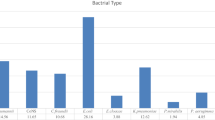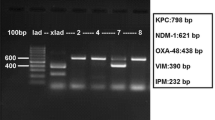Abstract
Background
Severe cases of infections caused by Raoultella planticola are constantly being reported from all over the world with the increase in drug-resistance patterns. In this study, we retrospectively evaluated the clinical characteristics of R. planticola infections with patients’ demographics and antimicrobial susceptibilities of the R. planticola isolates.
Methods
R. planticola isolates were retrospectively evaluated. VITEK 2® automated system was used for identification and antimicrobial susceptibility testing. Verification of the low-discriminated isolates was analyzed with MALDI-TOF method using VITEK MS® system. Gene-Xpert® system was used for detection of bla IMP-1-, bla KPC-, bla NDM-1-, bla OXA-48- and bla VIM-type carbapenemases. The data of the patients with R. planticola infection were collected from hospital records.
Result
During the 4-year period, 42 episodes of R. planticola infections were detected. MALDI-TOF was used for 11 of the low-discriminated isolates, and 1 of which identified as R. terrigena was excluded. Carbapenems and aminoglycosides were the most effective antimicrobial agents. Extended spectrum beta-lactamases were detected in seven of the isolates. Three carbapenem-resistant isolates were detected as bla OXA-48-type carbapenemase carrier. Nosocomial R. planticola infections constituted 80.9 % (n = 34) of the infections. Most common infections related with R. planticola were blood stream infections (n = 24) (p < 0.005). The presence of indwelling catheter and intensive care unit stay were the most common detected risk factors (p < 0.005). Diabetes mellitus and chronic renal insufficiency commonly accompanied the infections (p > 0.005).
Conclusions
Challenging infections caused by Raoultella spp., like those of multidrug resistant Klebsiella spp., will probably become a concern for clinicians as well as microbiologists . In literature, there were few cases, but we believe that the incidence of Raoultella spp. infections, which may result from misidentification, are more common than expected , and it is not unlikely that there will be a gradual increase and spread in multidrug-resistant isolates.
Similar content being viewed by others
References
Podschun R. Isolation of Klebsiella terrigena from human feces: biochemical reactions, capsule types, and antibiotic sensitivity. Int J Med Microbiol (formerly Zentralblatt fur Bakteriologie). 1991;275:73–8.
Bagley S, Seidler R, Brenner D. Klebsiella planticola sp. nov.: a new species of enterobacteriaceae found primarily in nonclinical environments. Curr Microbiol. 1981;6:105–9.
Drancourt M, Bollet C, Carta A, Rousselier P. Phylogenetic analyses of Klebsiella species delineate Klebsiella and Raoultella gen. nov., with description of Raoultella ornithinolytica comb. nov., Raoultella terrigena comb. nov. and Raoultella planticola comb. nov. Int J Syst Evol Microbiol. 2001;51:925–32.
Ferragut C, Izard D, Gavini F, et al. Klebsiella trevisanii: a new species from water and soil. Int J Syst Bacteriol. 1983;33:133–42.
Gavini FID, Grimont PAD, Beji A, et al. Priority of Klebsiella planticola Bagley, Seidler, and Brenner 1982 over Klebsiella trevisanii Ferragut, Izard, Gavini, Kersters, DeLey, and Leclerc 1983. Int J Syst Bacteriol. 1986;36:486–8.
Podschun R, Fischer A, Ullmann U. Characterization of Klebsiella terrigena strains from humans: haemagglutinins, serum resistance, siderophore synthesis, and serotypes. Epidemiol Infect. 2000;125:71–8.
Alves MS, Moreira BM, Riley LW. A case of severe pancreatitis complicated by Raoultella planticola infection. J Med Microbiol. 2007;56:696–8.
Chun S, Yun JW, Huh HJ, Lee NY. Low virulence? Clinical characteristics of Raoultella planticola bacteremia. Infection. 2014;42:899–904.
Hu AY, Leslie KA, Baskette J, Elsayed S. Raoultella planticola bacteraemia. J Med Microbiol. 2012;61:1488–9.
Kim SH, Roh KH, Yoon YK, et al. Necrotizing fasciitis involving the chest and abdominal wall caused by Raoultella planticola. BMC Infect Dis. 2012;12:59.
De Jong E, De Jong AS, Smidts-van den Berg N, Rentenaar RJ. Differentiation of Raoultella ornithinolytica/planticola and Klebsiella oxytoca clinical isolates by matrix-assisted laser desorption/ionization-time of flight mass spectrometry. Diagn Microbiol Infect Dis. 2013;75:431–3.
Granier SA, Leflon-Guibout V, Nicolas-Chanoine MH, Goldstein FW. Enterobacterial repetitive intergenic consensus 1R PCR assay for detection of Raoultella sp. Isolates among strains identified as Klebsiella oxytoca in the clinical laboratory. J Clin Microbiol. 2003;41:1740–2.
Castanheira M, Deshpande LM, Jones RN, et al. First descriptions of blaKPC in Raoultella spp. (R. planticola and R. ornithinolytica): report from the SENTRY antimicrobial surveillance program. J Clin Microbiol. 2009;47:4129–30.
Li J, Lan R, Xiong Y, et al. Sequential isolation in a patient of Raoultella planticola and Escherichia coli bearing a novel ISCR1 element carrying blaNDM-1. Plos One. 2014;9:e89893.
Monnet D, Freney J. Method for differentiating Klebsiella planticola and Klebsiella terrigena from other Klebsiella species. J Clin Microbiol. 1994;32:1121–2.
Park JS, Hong KH, Song SH, et al. Evaluation of three phenotypic identification systems for clinical isolates of Raoultella ornithinolytica. J Med Microbiol. 2011;60:492–9.
Deak E, Charlton CL, Bobenchik AM, et al. Comparison of the Vitek MS and Bruker Microflex LT MALDI-TOF MS platforms for routine identification of commonly isolated bacteria and yeast in the clinical microbiology laboratory. Diagn Microbiol Infect Dis. 2015;81:27–33.
Wolcott R, Dowd S. Molecular diagnosis of Raoultella planticola infection of a surgical site. J Wound Care. 2010;19:329–32.
Tseng SP, Wang JT, Liang CY, et al. First Report of bla(IMP-8) in Raoultella planticola. Antimicrob Agents Chemother. 2014;58:593–5.
Xu M, Xie W, Fu Y, et al. Nosocomial pneumonia caused by carbapenem-resistant Raoultella planticola: a case report and literature review. Infection. 2015;2:245.
Author information
Authors and Affiliations
Corresponding author
Ethics declarations
Conflict of interest
The authors declare that they have no conflict of interest.
Financial disclosure
The authors declare that this study has received no financial support.
Rights and permissions
About this article
Cite this article
Demiray, T., Koroglu, M., Ozbek, A. et al. A rare cause of infection, Raoultella planticola: emerging threat and new reservoir for carbapenem resistance. Infection 44, 713–717 (2016). https://doi.org/10.1007/s15010-016-0900-4
Received:
Accepted:
Published:
Issue Date:
DOI: https://doi.org/10.1007/s15010-016-0900-4




